‘Beauty and the Beast’ belongs to the Animal Groom cycle of fairy tales alongside ‘The Frog King’ and ‘Cupid and Psyche’. I have always been intrigued by what kind of animal Beast is in this tale. In his twenty first-century manifestation he has ram’s horns, a lion’s mane and a wolfish/bearish face:
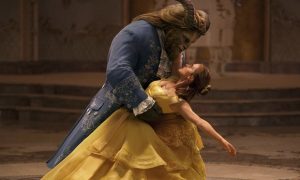
I am reliably informed that the 1991 Disney animation figures Beast as a buffalo in a reference to Native American culture and the fact there is an animal bridegroom folktale called ‘The Piqued Buffalo Wife’ from that part of the world.
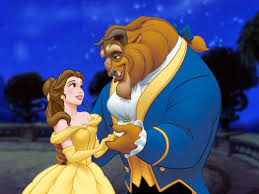
I have often seen him pictured as a human lion (see below)
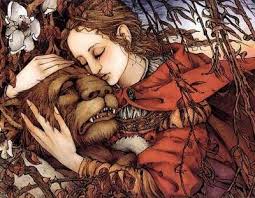
and @BillBloodyHughe reminded me that in the French 1740 original by Madame de Villeneuve, the Beast has scales and an elephant’s trunk:
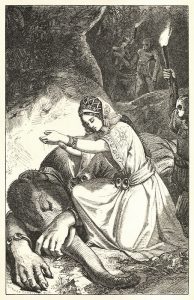
A 1765 version of this tale represents the beast as slightly more demonic looking resembling a black ram:
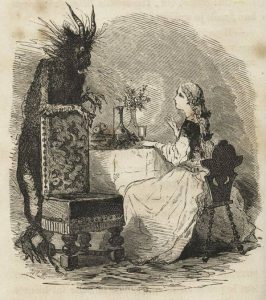
In fact he has an uncanny resemblance to Black Phillip from Robert Egger’s The Witch (2015)! He is more elegant and a warthog in many of the illustrations of the tale however, such as the one below:
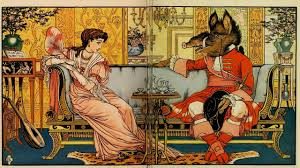
In Andrew Lang’s retelling of La Belle et la Bête par Madame de Villeneuve. Beast is shown with human hands and an elephant’s trunk objecting to the merchant’s stealing of a rose from his garden (1889).
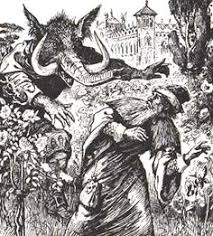
Then there is the bear/tiger/lion of Cocteau’s memorable film version of 1945 La belle et la bête
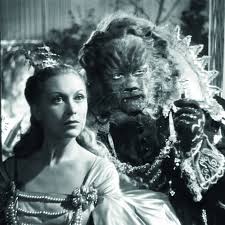
There are now versions which retell the tale from Beast’s point of view (Donna Jo Napoli, Beast (2004); Alex Flinn, Beastly (2007)). Robin McKinley’s Beauty (1978) is studied on OGOM’s Generation Dead: YA Fiction and the Gothic module which I developed and here Beast is wonderfully hybrid. He has a ‘heavy brown mane that falls to his shoulders’ (145) and is more civilised than savage, shown in his liking for fine food and wine (though he cannot wield a knife and fork because of his paws/claws!). He also has an extensive library full of books which haven’t been written yet (lovely trope) though he has trouble turning the pages (those paws again).
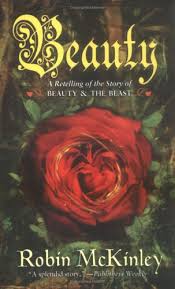
Beauty adds further mystery to the appearance of the Beast when she remarks on his human eyes and the fact that he is not ‘bearish’ at all. In fact she compares him to Yggdrasil, an immense mythical tree that connects the nine worlds in Norse cosmology. This is a good reason to read Neil Gaiman’s Norse Mythology (which I know Kaja has been enjoying but I have not got round to reading it yet alas).
“I realised that what made his gaze so awful was that his eyes were human. We looked at each other a moment. Not bearish at all, I decided. Not like anything else I could put a name to either. If Yggdrasil had been given an animal’s shape, it might have looked like the beast” (Robin McKinley’s Beauty, p. 131)
So the Beast is compared to an animal/human tree in McKinley. Hybridity is debated widely in the vegetable world too. Taxonomy has been something that has always been a part of my research because of my botanical interests. Hybrid blooms known as ‘exotics’ (such as parrot tulips or double hyacinths) tend to be considered ‘monstrous’ because they do not produce good seed, are not pure stock, and because ‘nature’ can no longer be found among them. Animal hybrids such as the mule are also thought to be debased and are infertile. Beast is one of only a few positive images of hybridity in the popular imagination, though of course the tale is ambiguous and he has to become fully human for the union to be legalised in marriage. I posted on hybridity and the Wellcome Institute’s Making Nature Exhibition recently. This is a very intelligent exploration of taxonomy including faux classification and animal/human hybrids such as Beast so do try to catch the show.
The furore surrounding the new Disney version seems to be focussed on Belle or Beauty rather than Beast, perhaps due to the celebrity nature of its star Emma Watson, whereas the Disney animation previously gave us a Beast-centred narrative, devoted almost exclusively to the development or regeneration of the unregenerate male figure. Further discussions of the Disney version can be found in Jack Zipes ‘Breaking the Disney Spell’ in Tatar ed. The Classic Fairy Tales (New York: W.W. Norton, 1999), pp. 332-352.
If you have seen Beauty and the Beast you might be interested in the following articles from The Guardian ‘Beauty and the Beast: Dark History of a Literary Fairy Tale’ and ‘The Beauty and the Beast in La La Land’ on the various musical versions. It will be hard for any adaptation to out do Cocteau’s for me. It was the first to fully bring out the unsettling Gothic elements in the tale. I’d like to see a version where the animal and human are reversed with a wolf as Beauty and a human Beast. Of course in Carter’s version, ‘The Tiger’s Bride’, which is the most subversive, instead of Beast becoming human, Beauty herself transforms and becomes furred …absolute genius!
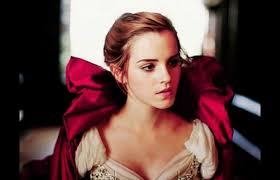

I really enjoyed reading this. I always saw him as lion-ish. I’m not sure why – I suspect because I still tried to make him attractive and ‘The Lion King’ made me decide that lions could be good looking in a cross-species way. (Disney encourages bestiality?) I’m meaning to get up to the Wellcome Collection to see the ‘Making Nature’ exhibition. Fingers crossed I can get there soon.
Ha yes he does have a mane in many versions. Lions are always noble and regal so perhaps that is why he his characterised in this way. I was influenced by the ‘Singing Ringing Tree’ which was on TV back in the day. It was a version of Beauty and the Beast and he was a rather melancholic bear in that so I still see him as a bear! I mentioned it in my top ten shapeshifters because it had a profound effect on me and was very magical and other wordly. Bill says there are versions where he is a wolf so I am awaiting my new Tatar book on versions of the story from around the world so I can find it!
I don’t know whether it’s just me or if perhaps everybody else experiencing issues with your site.
It seems like some of the written text in your content are running off the screen.
Can somebody else please provide feedback and let me know if this is happening to them as well?
This could be a issue with my internet browser because I’ve had
this happen before. Appreciate it
Sorry you’re having problems, but we’d need more details–which pages is this happening with, what browser and what device.
The story has many versions. But the one that inspired the thieving french writter I think is Lilly and the lion. Also the lion has no human features except speech. In his diurnal form looks just like a lion. At night it becomes a fully human prince. So no hybrid.
What do you mean by ‘Lily and the Lion’? I’m not sure I know that story. But I think it’s a mistake to call Villeneuve ‘thieving’–literature has always been a complex process of borrowing and influence
Lilly and the Lion is the Brothers Grimm (german) version of an ancestral story on which Beauty and the beast is based on. The main difference is Villeneuve trying to remove all morals from the story. First off the prince is cursed because he refused an arranged marriage with a princess whose mother is an evil witch. Second the curse states that a girl has to accept him as is for a period of time for the curse to be broken. Third the girl at the advice of a female relative breakes her promise in the attempt to have him human for the entire time and him and the castle and everything dissapears. Fourth she has to search for him for years (in some versions being pregnant) and only by the goodness of strangers with which she interacts (in some stories are female cannibals in others sun, moon, stars and winds) she manages to find the castle of the princess. Note that if she were not kind and gentle and hard working those strangers instead of helping her would have killed her. To recover her husband she sells gifts received from the strangers to the princess to spend one night with the prince. the first two the prince is drugged and cannot wakeup but the third he does not drink the sleeping potion and wakes up as she cries next to his bed. They escape miraculuously and happy ending. The point is all the part of her suffering because she disobeyed her husband at the advice of another woman is cut off from Beuaty and the Beast and is extremely important. Most trace the story to Cupid and Psyche but is debatable. Also note that in every version of the story except this one there is a clear identification of what the beast is ( what animal) and about the reason of the curse and so on. Now the initial part of beauty and the beast with the reason for the curse is cobbled from another story where a boy is cursed of falling in love of a fairy for breaking out of malice the jar of an old woman that came to get water from the fountain. Unlike other stories beauty and the beast story is quite nonsensical.